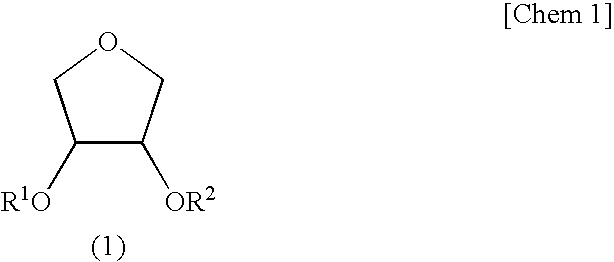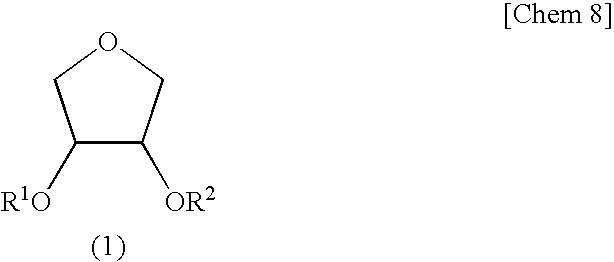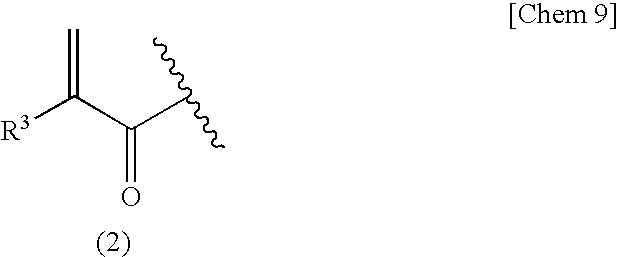(METH) acryloyloxytetrahydrofurans and process for production thereof
- Summary
- Abstract
- Description
- Claims
- Application Information
AI Technical Summary
Benefits of technology
Problems solved by technology
Method used
Image
Examples
referential example 1
[0134]Synthesis of Erythritan (cis-3,4-dihydroxytetrahydrofuran)>
[0135]Into a reaction vessel fitted with a distillation-cooling part were charged 30.0 g (246 mmol) of erythritol and 0.50 g (2.6 mmol, 1.1 molar equivalents) of p-toluenesulfonic acid monohydrate. Then, the pressure in the system was reduced to 70 Pa and the whole was heated on an oil bath to initiate the reaction. When a period of 25 minutes was passed, a cyclic product erythritan started to distill and a fraction having a distillation temperature of 105 to 107° C. was obtained by fractionation (18.22 g; yield 71.1%). When it was analyzed by gas chromatography, an area purity was 99.4% and it was found that it contained 16 mol % of H2O on 1H-NMR.
[0136]A 5.03 g portion of thus obtained hydrated erythritan was diluted with 20 g of toluene and then the toluene was removed by distillation by means of a rotary evaporator. This operation was repeated further twice. Drying under reduced pressure at 40° C. afforded 5.00 g of...
example 1
[0137]Into a reactor thorough which nitrogen was passed were charged 1.00 g (9.61 mmol) of erythritan containing 10 mol % of water, 1.46 g (14.4 mmol, 1.5 eq) of triethylamine, and 5 g of methyl isobutyl ketone (MIBK), followed by cooling with salt-ice so that the temperature in the system became −10° C. Thereto was slowly added dropwise 0.835 g (7.99 mmol, 0.83 eq. to erythritan) of methacryloyl chloride (purity 82%) over a period of 15 minutes. After the dropwise addition, the reaction was continued for 10 hours with slowly elevating the temperature to 0° C. After completion of the reaction, the reaction solution was poured into 10 mL of water and extracted with 20 mL of ethyl acetate. The ethyl acetate layer was washed with 5 mL of 1N HCl twice, 5 mL of a saturated sodium hydrogen carbonate aqueous solution once, and 5 mL of a saturated sodium chloride aqueous solution once and then dried over magnesium sulfate. After drying, ethyl acetate was removed by distillation by means of ...
example 2
[0147]The reaction and purification were carried out in the same manner except than water contained in the erythritan was less than 1 mol % and the amount of the methacryloyl chloride used was 0.895 g (8.56 mmol, 0.89 eq. to erythritan) to obtain the following products.[0148]Erythritan monomethacrylate of a colorless oil 501 mg (yield based on methacryloyl chloride 34%, GC purity: 96%, GPC purity: 81%).[0149]Erythritan dimethacrylate of a light yellow oil 412 mg (yield based on methacryloyl chloride 40.1%, GC purity: 89%, GPC purity: 98%).
PUM
| Property | Measurement | Unit |
|---|---|---|
| Percent by mass | aaaaa | aaaaa |
| Fraction | aaaaa | aaaaa |
| Percent by mole | aaaaa | aaaaa |
Abstract
Description
Claims
Application Information
 Login to View More
Login to View More - R&D
- Intellectual Property
- Life Sciences
- Materials
- Tech Scout
- Unparalleled Data Quality
- Higher Quality Content
- 60% Fewer Hallucinations
Browse by: Latest US Patents, China's latest patents, Technical Efficacy Thesaurus, Application Domain, Technology Topic, Popular Technical Reports.
© 2025 PatSnap. All rights reserved.Legal|Privacy policy|Modern Slavery Act Transparency Statement|Sitemap|About US| Contact US: help@patsnap.com



